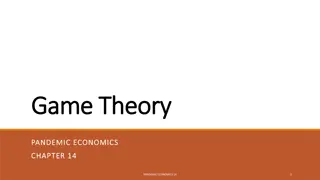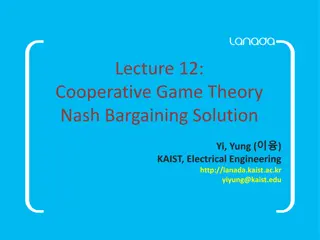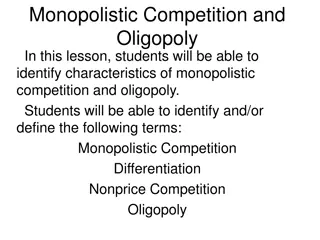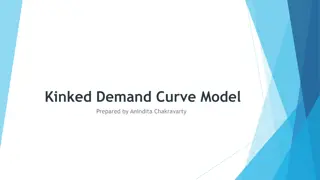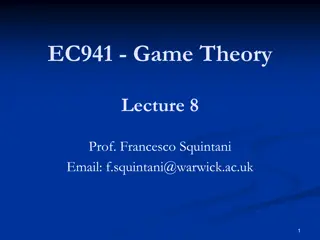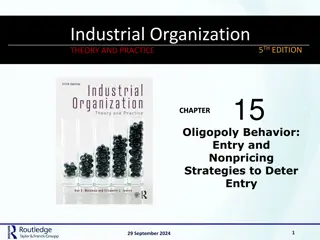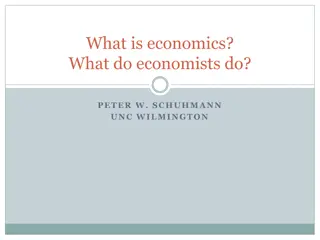Understanding Game Theory and Oligopoly in Economics
Game theory is a valuable tool for analyzing strategic interactions among players in situations like oligopoly. The concept of dominant strategy and the classic example of the Prisoner's Dilemma shed light on how individual rationality can lead to suboptimal outcomes. The practical example of a cell phone duopoly in a small town further illustrates the implications of different market structures on pricing, output, and profits.
Download Presentation

Please find below an Image/Link to download the presentation.
The content on the website is provided AS IS for your information and personal use only. It may not be sold, licensed, or shared on other websites without obtaining consent from the author. Download presentation by click this link. If you encounter any issues during the download, it is possible that the publisher has removed the file from their server.
E N D
Presentation Transcript
Game Theory Game theory helps us understand oligopoly and other situations where players interact and behave strategically. Dominant strategy: a strategy that is best for a player in a game regardless of the strategies chosen by the other players Prisoners dilemma: a game between two captured criminals that illustrates why cooperation is difficult even when it is mutually beneficial 2 OLIGOPOLY
Prisoners Dilemma Example The police have caught Bonnie and Clyde, two suspected bank robbers, but only have enough evidence to imprison each for 1 year. The police question each in separate rooms, offer each the following deal: If you confess and implicate your partner, you go free. If you do not confess but your partner implicates you, you get 20 years in prison. If you both confess, each gets 8 years in prison. 3 OLIGOPOLY
Prisoners Dilemma Example Confessing is the dominant strategy for both players. Nash equilibrium: both confess Bonnie s decision Confess Remain silent Bonnie gets 8 years Bonnie gets 20 years Confess Clyde gets 8 years Clyde goes free Clyde s decision Bonnie goes Bonnie gets 1 year free Remain silent Clyde gets 1 year Clyde gets 20 years 4
Prisoners Dilemma Example Outcome: Bonnie and Clyde both confess, each gets 8 years in prison. Both would have been better off if both remained silent. But even if Bonnie and Clyde had agreed before being caught to remain silent, the logic of self-interest takes over and leads them to confess. 5 OLIGOPOLY
EXAMPLE: Cell Phone Duopoly in Smalltown Competitive outcome: P = MC = $10 Q = 120 Profit = $0 P Q Revenue Cost Profit $0 140 $0 $1,400 1,400 5 130 650 1,300 650 10 120 1,200 1,200 0 15 110 1,650 1,100 550 20 100 2,000 1,000 1,000 25 90 2,250 900 1,350 Monopoly outcome: P = $40 Q = 60 Profit = $1,800 30 80 2,400 800 1,600 35 70 2,450 700 1,750 40 60 2,400 600 1,800 45 50 2,250 500 1,750 6 OLIGOPOLY
EXAMPLE: Cell Phone Duopoly in Smalltown One possible duopoly outcome: collusion Collusion: an agreement among firms in a market about quantities to produce or prices to charge T-Mobile and Verizon could agree to each produce half of the monopoly output: For each firm: Q = 30, P = $40, profits = $900 Cartel: a group of firms acting in unison, e.g., T-Mobile and Verizon in the outcome with collusion 7
Oligopolies as a Prisoners Dilemma When oligopolies form a cartel in hopes of reaching the monopoly outcome, they become players in a prisoners dilemma. Our earlier example: T-Mobile and Verizon are duopolists in Smalltown. The cartel outcome maximizes profits: Each firm agrees to serve Q = 30 customers. 8 OLIGOPOLY
T-Mobile & Verizon in the Prisoners Dilemma Each firm s dominant strategy: renege on agreement, produce Q = 40. T-Mobile Q = 30 Q = 40 T-Mobile s profit = $900 T-Mobile s profit = $1000 Q = 30 Verizon s profit = $900 Verizon s profit = $750 Verizon T-Mobile s profit = $750 T-Mobile s profit = $800 Q = 40 Verizon s profit = $800 Verizon s profit = $1000 9
The Equilibrium for an Oligopoly Nash equilibrium: a situation in which economic participants interacting with one another each choose their best strategy given the strategies that all the others have chosen Our duopoly example has a Nash equilibrium in which each firm produces Q = 40. Given that Verizon produces Q = 40, T-Mobile s best move is to produce Q = 40. Given that T-Mobile produces Q = 40, Verizon s best move is to produce Q = 40. 10 OLIGOPOLY
In the following, let the market demand curve be P = 70 - 2Q, and assume all sellers can produce at a constant marginal cost of c = 10, with zero fixed costs. a) If the market is perfectly competitive, what is the equilibrium price and quantity? b) If the market is controlled by a monopolist, what is the equilibrium price and quantity? How much profit does the monopolist earn? c) Now suppose that Amy and Beau compete as duopolists. What is the equilibrium price? What is total market output, and how much profit does each seller earn?
Boeing and Airbus are competing to fill an order of jets for Singapore Airlines. Each firm can offer a price of $10 million per jet or $5 million per jet. If both firms offer the same price, the airline will split the order between the two firms, 50 50. If one firm offers a higher price than the other, the lower-price competitor wins the entire order. Here is the profit that Boeing and Airbus expect they could earn from this transaction: If both firm formed a cartel agreement, at what price each firm sell the jet? What is the Nash equilibrium in this game? If Boeing could move first and credibly commit to its capacity expansion strategy, what is its optimal strategy? What will Airbus do?
Other Examples of the Prisoners Dilemma Ad Wars Two firms spend millions on TV ads to steal business from each other. Each firm s ad cancels out the effects of the other, and both firms profits fall by the cost of the ads. Organization of Petroleum Exporting Countries Member countries try to act like a cartel, agree to limit oil production to boost prices & profits. But agreements sometimes break down when individual countries renege. 13 OLIGOPOLY
Other Examples of the Prisoners Dilemma Arms race between military superpowers Each country would be better off if both disarm, but each has a dominant strategy of arming. Common resources All would be better off if everyone conserved common resources, but each person s dominant strategy is overusing the resources. 14 OLIGOPOLY
Prisoners Dilemma and Societys Welfare The noncooperative oligopoly equilibrium Bad for oligopoly firms: prevents them from achieving monopoly profits Good for society: Q is closer to the socially efficient output P is closer to MC In other prisoners dilemmas, the inability to cooperate may reduce social welfare. e.g., arms race, overuse of common resources 15 OLIGOPOLY
Another Example: Negative Campaign Ads Election with two candidates, R and D. If R runs a negative ad attacking D, 3000 fewer people will vote for D: 1000 of these people vote for R, the rest abstain. If D runs a negative ad attacking R, R loses 3000 votes, D gains 1000, 2000 abstain. R and D agree to refrain from running attack ads. Will each one stick to the agreement? 16 OLIGOPOLY
Another Example: Negative Campaign Ads Each candidate s dominant strategy: run attack ads. R s decision Run attack ads (defect) Do not run attack ads (cooperate) no votes lost R gains 1000 Do not run attack ads (cooperate) or gained votes no votes lost or gained D loses 3000 votes D s decision R loses 3000 R loses 2000 votes votes Run attack ads (defect) D loses 2000 votes D gains 1000 votes 17
Another Example: Negative Campaign Ads Nash eq m: both candidates run attack ads. Effects on election outcome: NONE. Each side s ads cancel out the effects of the other side s ads. Effects on society: NEGATIVE. Lower voter turnout, higher apathy about politics, less voter scrutiny of elected officials actions. 18 OLIGOPOLY
Why People Sometimes Cooperate When the game is repeated many times, cooperation may be possible. These strategies may lead to cooperation: If your rival reneges in one round, you renege in all subsequent rounds. Tit-for-tat Whatever your rival does in one round (whether renege or cooperate), you do in the following round. 19 OLIGOPOLY
Public Policy Toward Oligopolies Recall one of the Ten Principles from Chap.1: Governments can sometimes improve market outcomes. In oligopolies, production is too low and prices are too high, relative to the social optimum. Role for policymakers: Promote competition, prevent cooperation to move the oligopoly outcome closer to the efficient outcome. 20 OLIGOPOLY
Restraint of Trade and Antitrust Laws Sherman Antitrust Act (1890): Forbids collusion between competitors Clayton Antitrust Act (1914): Strengthened rights of individuals damaged by anticompetitive arrangements between firms 21 OLIGOPOLY
Controversies Over Antitrust Policy Most people agree that price-fixing agreements among competitors should be illegal. Some economists are concerned that policymakers go too far when using antitrust laws to stifle business practices that are not necessarily harmful, and may have legitimate objectives. We consider three such practices 22 OLIGOPOLY
1. Resale Price Maintenance (Fair Trade) Occurs when a manufacturer imposes lower limits on the prices retailers can charge. Is often opposed because it appears to reduce competition at the retail level. Yet, any market power the manufacturer has is at the wholesale level; manufacturers do not gain from restricting competition at the retail level. The practice has a legitimate objective: preventing discount retailers from free- riding on the services provided by full-service retailers. 23 OLIGOPOLY
2. Predatory Pricing Occurs when a firm cuts prices to prevent entry or drive a competitor out of the market, so that it can charge monopoly prices later. Illegal under antitrust laws, but hard for the courts to determine when a price cut is predatory and when it is competitive & beneficial to consumers. Many economists doubt that predatory pricing is a rational strategy: It involves selling at a loss, which is extremely costly for the firm. It can backfire. 24 OLIGOPOLY
3. Tying Occurs when a manufacturer bundles two products together and sells them for one price (e.g., Microsoft including a browser with its operating system) Critics argue that tying gives firms more market power by connecting weak products to strong ones. Others counter that tying cannot change market power: Buyers are not willing to pay more for two goods together than for the goods separately. Firms may use tying for price discrimination, which is not illegal, and which sometimes increases economic efficiency. 25 OLIGOPOLY
CONCLUSION Oligopolies can end up looking like monopolies or like competitive markets, depending on the number of firms and how cooperative they are. The prisoners dilemma shows how difficult it is for firms to maintain cooperation, even when doing so is in their best interest. Policymakers use the antitrust laws to regulate oligopolists behavior. The proper scope of these laws is the subject of ongoing controversy. 26 OLIGOPOLY





